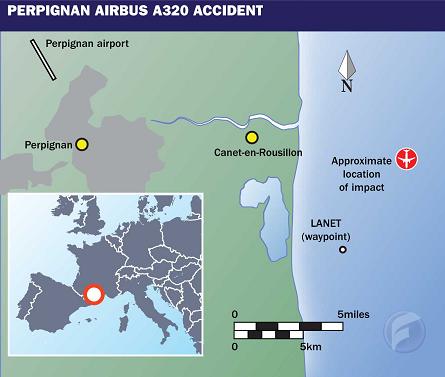Search and rescue personnel at the crash scene of the Air New Zealand-owned Airbus A320 off the coast of France have obtained location transmissions from the aircraft's two flight recorders.
But retrieval of the devices has been hampered by deteriorating weather conditions at the site, east of Perpignan and some 3.5nm (6.5km) from the shore.
US National Transportation Safety Board representatives are to assist the inquiry. The NTSB is to dispatch a team to France - supported by US FAA and International Aero Engines technical advisers - once recovery of the wreckage begins.
French accident-response organisation Service Departemental d'Incendie et de Secours' local division, SDIS 66, which has established a command post at the nearby port of Canet, confirms that two bodies have been recovered but says there is little chance of finding anyone else alive. Four of the seven occupants were ANZ employees, a fifth was an observer from New Zealand's civil aviation authority. The other two were German pilots.
The initial debris field, SDIS adds, was spread over 300m (980ft), while the aircraft's fuselage is lying at a depth of about 34m. Several vessels and several divers from both SDIS 66 and the coastal rescue service, Societe Nationale de Sauvetage en Mer, are in the area, backed by aerial support.
 |
|---|
© Tim Brown/Flight |
Air New Zealand says it has been advised of the recorder transmission detection. Up to 75 personnel are still attending the crash scene but ANZ group general manager, international airline, Ed Sims says high winds, cool temperatures and increasingly-rough seas are creating difficult working conditions.
He adds that French authorities have informed ANZ that the aircraft broke up on impact, and says: "All evidence on site indicates that, given the nature of the impact, there is no chance of survivors. Debris is spread over a large areas and it appears the aircraft is not in large pieces, as originally indicated by those who saw the impact."
French investigation agency Bureau d'Enquetes et d'Analyses states that the aircraft - being returned off lease from the German division of XL Airways - had been airborne for about an hour, performing a "circular" flight, and was conducting an approach to Perpignan Airport when the accident occurred at 16:46 on 27 November.
 |
|---|
© French Frogs Aviation Pictures |
There is no evidence that the crew of the aircraft declared an emergency before the accident.
Unconfirmed reports, citing air traffic control communication, suggest that the aircraft had been cleared to descend to 4,000ft and directed to the LANET waypoint, a reference on the holding pattern for Perpignan's runway 33, from where it would perform an instrument approach.
Reports citing a local police eyewitness, again unconfirmed, indicate that the loss of the aircraft was sudden, the jet having apparently entered a sharp dive towards the sea from which it failed to recover.
Source: Air Transport Intelligence news



















